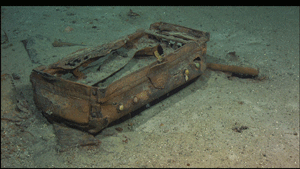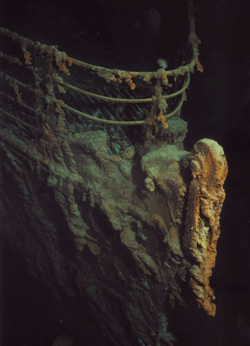As archaeology is a sub-discipline within the field of Anthropology, archaeology has a few sub-disciplines itself. One of which is Maritime Archaeology, otherwise known as underwater archaeology or marine archaeology. Maritime Archaeology is the study and preservation of human interaction with the sea. Maritime archaeology isn’t restricted to just the sea and/or ocean, it can focus on either wet or dry sites. This archaeological field includes ships, shipwrecks, sunken cities, landscapes, indigenous fish traps, and human remains. Artifacts that have been submerged under water for hundreds of years are especially important and very fragile, so underwater archaeologists have to be extremely careful not to damage them during an excavation. When doing underwater excavations archaeologists also have to worry about things such as underwater earthquakes, volcanoes, and underwater animals such as sharks, which could end up harming them and the artifacts in the excavations site. Underwater sites are also harder to get access to so maritime archaeologist have to be skilled swimmers and divers. It is not easy for underwater archaeologists as they must work and excavate in the deep sea instead of on land as usual.

Although the field of maritime archaeology is virtually unknown some its most famous sites are not. One of the most famous is the Titanic, the 1912 shipwreck that claimed over 1,500 lives.
It was discovered in 1985 and from then on it became an archaeological site. In 2012, robot vehicles with sonar and cameras were to used to create a map of the shipwreck. a scientific mission to the Titanic used robotic vehicles equipped with sonar and cameras to create a detailed map of the wreck site, as well as high-resolution three-dimensional documentation of the fragmented ship’s various components. As a result of this excavation along with others it has been discovered that the Titanic is falling apart due to the rust, decay, and marine organisms such as mollusks and fungi eating away at the ship’s wood and the ship in general.

Another lesser known site is the lost city of Thonis-Heracleion, Egypt. Thought to be legend, this was a temple city dedicated to the Egyptian god Amun, the god of the sun and the air. It was also a port entry for Greek ships to come to Egypt. This lost city has also been mentioned in Greek myths by the Greek historian Herodotus, it is the city where Herakles (Hercules) first stepped foot into Egypt, and the city where Helen of Troy spent time with Paris before the Trojan War. It sunk around 8th century AD, but it was officially discovered in 2000 and the underwater archaeologist who discovered it, Franck Goddio, described it as a “civilization frozen in time”. The city was magnificent and was one of international trade, when it was excavated archaeologists found colossal statues, temples, gold, jewelry, ceramics, and coins. Over 70 wrecks and seven hundred various anchors were found at the site. Sites like this lost city and shipwrecks like the Titanic are still being discovered and preserved today.

The field of Maritime Archaeology is important in the understanding and preservation of the world’s underwater cultural heritage. When I first learned of this field I thought it was cool and I loved the underwater pictures of Thonis-Heracleion. This is a great example of how broad and amazing anthropology and its sub-disciplines are.
P.S.- There are so many amazing pictures from the Thonis-Heracleion excavation that it was hard to choose which ones would be put on here. If you are interested in seeing more pictures of the excavation click on the links under the pictures.


rzc5560
October 3, 2020 at 9:11 pmThis is so cool. Reading about the lost city of Thonis-Heracleion did momentarily send me back to my middle school egyptian mythology obsession so thank you for that. This entire subgrene of archology is honestly something I had never really considered before, but its honestly really cool. I do have a bit of a strange connection to it though. My grandmother is from a town in Ireland called Kilcormac, in County Offaly, which is known mostly for the amount of bog bodies theyve found. One of the most famous is called “Old Croghan Man,” and he’s about 2000 years old. Because of the lack of oxygen in the bog, which used to be a lake, the body is pretty well preserved (the whole process is kinda close to pickling, which is, in my opinion, kinda weird to think about.) Anyway, I’m not sure what the official mythology is behind him, but I do remember my grandmother telling me he was an evil king who would come alive again every halloween.
slh6222
October 4, 2020 at 2:23 pmIt’s funny, we always hear about people wanting to go into marine biology, but not maritime archaeology! As someone with a major fear of drowning, I could never pursue this profession, but this is so interesting! My mind immediately went to the lost city of Atlantis, but I was super excited to read about the lost city of Thonis-Heracleion (an artifact I had never heard of). Our Earth is about 70% water, yet only 5% of the ocean has been explored. As people search for written artifacts to unveil the past, we have to wonder if we could extract more information from these sunken artifacts – not just geologically, but also anthropologically. Fascinating post!
Blake Lipko
October 5, 2020 at 3:40 amI’ve always had a fascination with “lost cities” and other artifacts that are underwater. It’s interesting to know that researchers were able to successfully map out the Titanic, as I always loved learning about it in school and in television shows as a kid. I think this would be such a cool job to take part in yet I feel like it would also be quite frightening at the same time with the uncertainty brought by the sea.
nxw5198
October 5, 2020 at 3:54 amHow exactly does a city just sink??? I’ve always been fascinated by stories of Atlantis and lost civilizations, but I have no real life visualizations other than that I know from movies. Like I just imagine the scene from Ice Age where the squirrel pulls an acorn plug that causes the decent of squirrel civilization into the depths of the seas. It is probably more complex than that but that’s my understanding of it. I really enjoyed reading about Thonis-Heracleion and all the cool stuff underwater, which is kinda crazy knowing that we know more about space than about our own oceans. Great Post!